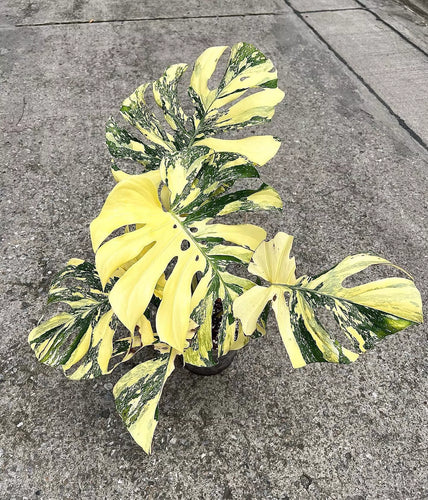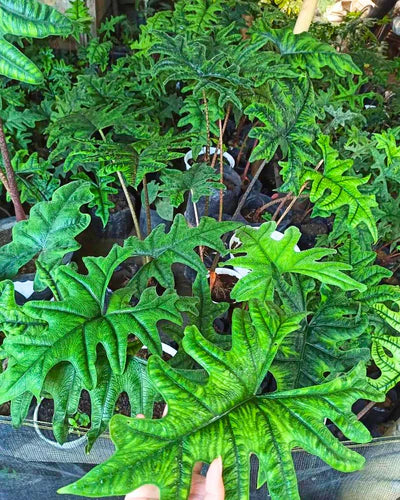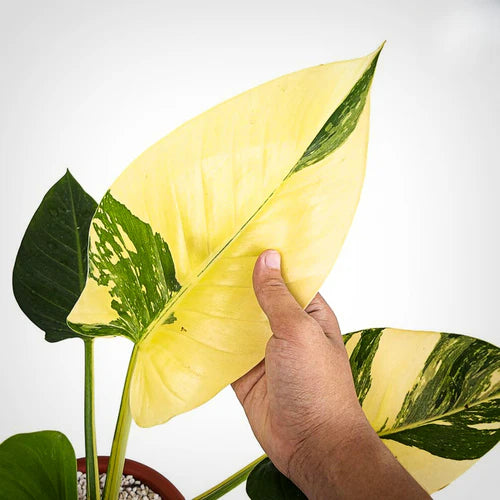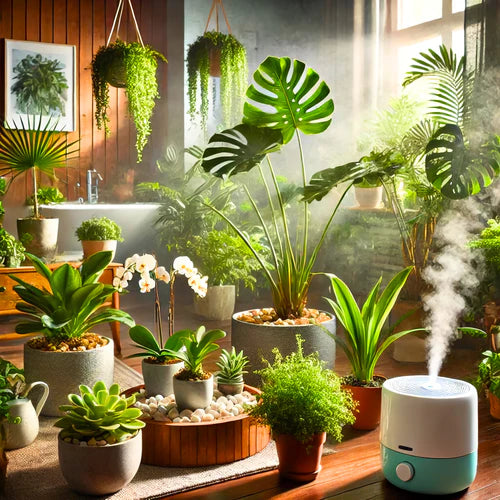Philodendron Black Cherry vs Pink Princess
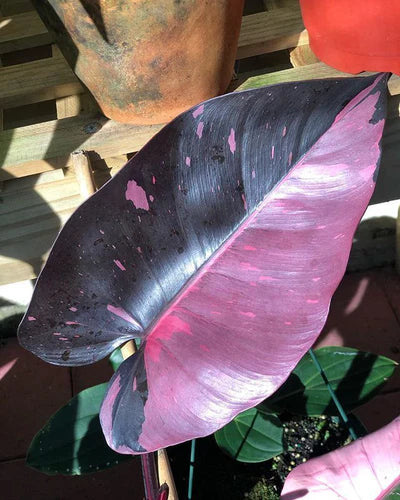
What's the difference with Philodendron Black Cherry vs Pink Princess?
In the wide-ranging world of houseplants, the Philodendron genus holds a special place. With its diverse varieties, it captivates the hearts of both novice and seasoned plant enthusiasts. Two such varieties that often spark debate among plant lovers are the Philodendron Black Cherry and Pink Princess. But what sets them apart? What are the care requirements for each? This blog aims to address these questions and more.
Table of Contents
- Introduction
- What Makes Them Special
- Color Variations
- Foliage and Texture
- Origin and History
- The Pink Princess Philodendron
- The Black Cherry Pink Princess
- Care Essentials
- Light and Positioning
- Watering
- Humidity and Temperature
- Soil Mix
- Fertilizing
- Plant Tools
- Humidifier
- Moisture Meter
- Grow Lights
- Light Meter
- Benefits of Owning These Philodendrons
- Air-Purifying Qualities
- Aesthetic Appeal
- Troubleshooting
- Yellow Leaves
- Pest Control
- Root Rot
- Potting and Repotting
- When to Repot
- How to Repot
- Comparison: Pink Princess vs Black Cherry Pink Princess
- Appearance
- Care Requirements
- Cost
- Cost and Affordability
- Standard Prices
- Where to Buy
- Essential Accessories
- Soil Amendments
- Pest Control Options
- Propagation Steps
- Philodendron Black Cherry
- Pink Princess Philodendron
- Where to Buy: A Locational Guide
- Local Nurseries
- Online Stores
- Social Media Plant Groups
- Black Cherry Pink Princess Frequently Asked Questions
- How often should I water my Philodendron?
- Can I keep my Philodendron Black Cherry and Pink Princess in low light?
- What are the common pests that can affect my Philodendron?
- What is the difference between Pink Princess and Black Cherry?
- How do you care for a Black Cherry Pink Princess?
- Are Black Cherry Philodendrons real?
- Conclusion
What Makes Them Unique?
Philodendron Black Cherry
The Black Cherry Pink Princess, a variant of the Pink Princess, is renowned for its unique coloration. The leaves can appear as a mix of dark green and purple with maroon undersides. The 'Black Cherry' gets its name from the almost black hues that its leaves display as they mature.
Pink Princess Philodendron
The Pink Princess, on the other hand, is famous for its pink variegated leaves. Unlike the darker hues of the Black Cherry, the Pink Princess showcases a blend of dark green and vivid pink.
Both types come from the same Philodendron genus but differ significantly in appearance, making each a statement piece in your living space.
Philodendron Black Cherry
- Leaves: Generally larger and broader compared to Pink Princess.
- Color: Darker shades predominate, with hues ranging from deep green to almost black.
- Variegation: Less pronounced compared to Pink Princess.
For a comprehensive care guide tailored for Philodendron Black Cherry, you can visit PlantVault's Black Cherry care guide.
Pink Princess Philodendron
- Leaves: Generally smaller, with a more elongated shape.
- Color: A combination of pink and green, offering a brighter appearance.
- Variegation: Highly sought after, often commanding higher prices for more variegated specimens.
Ideal Growing Conditions
Despite their differences, both the Black Cherry and Pink Princess have somewhat similar care requirements.
- Temperature: Both varieties prefer temperatures ranging from 65-75°F.
- Humidity: A high humidity level of around 60% is ideal. Using a humidifier can help maintain optimal conditions.
- Watering: Neither should be left in standing water. A moisture meter can help gauge the perfect time for watering.
Soil Requirements
When it comes to soil, a well-draining medium is essential for both. An aroid mix is an excellent choice, but you can also create your own mixture by adding perlite and organic compost.
Light Needs
- Philodendron Black Cherry: Prefers medium to bright indirect light but can tolerate low light conditions. A light meter can help you determine the most suitable location.
- Pink Princess Philodendron: Thrives in medium to bright indirect light but is less tolerant of low light compared to Black Cherry.
To ensure that your plants get enough light, especially during the winter months, you may consider investing in grow lights.
Watering Routine
Understanding the specific watering needs of your plant can be the difference between a thriving or dying specimen.
Philodendron Black Cherry
- Frequency: Once the top 1-2 inches of soil feel dry.
- Indicator: Drooping leaves can often signify dehydration.
- Tip: Use a moisture meter to precisely measure soil moisture levels.
Pink Princess Philodendron
- Frequency: Slightly more often than the Black Cherry due to smaller leaves that lose moisture quickly.
- Indicator: Browning leaf tips may indicate underwatering.
- Tip: For both types, using a Humidifier can keep the ambient moisture high, mitigating water loss from leaves.
Fertilization Needs
Philodendron Black Cherry
- Type of Fertilizer: Slow-release pellets or liquid fertilizer are generally more beneficial.
- Frequency: Fertilize once every 6-8 weeks using a slow-release fertilizer.
Pink Princess Philodendron
- Type of Fertilizer: Prefers a balanced liquid fertilizer.
- Frequency: Fertilize once every 4-6 weeks.
Adding worm castings to the soil can provide essential nutrients and improve soil structure.
Common Pests and Solutions
- Mealybugs: A cotton-like substance on the plant; treat with insecticidal soap.
- Spider Mites: Tiny web-like structures; neem oil works well.
- Aphids: Tiny bugs that can be washed away or treated with Bonide Systemic Houseplant Insect Control.
For more tips on dealing with pests, you can refer to PlantVault’s comprehensive guide.
Repotting Tips
Repotting should be undertaken with care to prevent root shock.
- Soil: Use a fresh batch of aroid mix or add organic compost to your existing soil.
- Frequency: Generally, every 18-24 months is sufficient.
Growth Support: Climbing and Training
These Philodendrons are climbers by nature, and providing proper support is essential.
- Moss Poles: Using a clear moss pole for climbing plants can help your Philodendron climb and grow vertically.
- Leca: For those who prefer a soil-less medium, Leca can be a good alternative.
The Cost Factor
The Pink Princess Philodendron generally tends to be pricier than its Black Cherry counterpart due to the high demand for its variegated leaves. Prices can range from $50 to even $500 for highly variegated specimens.
Propagation Steps
Propagation not only extends your plant family but also rejuvenates older plants.
Philodendron Black Cherry
- Method: Stem Cuttings
- Step-by-Step:
- Cut a 4-6 inch stem below a node.
- Let the cutting callus for a few hours.
- Plant in a mixture of sphagnum moss and perlite.
Pink Princess Philodendron
- Method: Air Layering
- Step-by-Step:
- Make a small incision on the stem.
- Wrap it with moist sphagnum moss.
- Cover it with plastic and wait for roots to develop.
Where to Buy: A Locational Guide
Whether you're in Carlsbad, California, or elsewhere, acquiring a Philodendron Black Cherry or Pink Princess is not as difficult as you might think.
- Local Nurseries: Best for immediate satisfaction.
- Online Stores: A broader selection is available. For instance, PlantVault offers a variety of options.
- Social Media Plant Groups: Good for trades.
Remember, we ship anywhere in the United States. Visit our showroom appointment page for more details if you want to come visit our houseplant showroom/greenhouse in person.
Black Cherry Pink Princess Frequently Asked Questions
How often should I water my Philodendron?
This varies but usually, when the top 1-2 inches of soil are dry.
Can I keep my Philodendron Black Cherry and Pink Princess in low light?
Not advisable. A light meter can help you gauge the optimal lighting conditions.
What are the common pests that can affect my Philodendron?
Mealybugs, Spider Mites, and Aphids are the most common pests. Using grow lights can not only help with growth but also deter some pests.
What is the difference between Pink Princess and Black Cherry?
The Pink Princess generally has more of a contrast between its pink and green leaves, whereas the Black Cherry has a subtler blend of colors, leading to a darker appearance.
How do you care for a Black Cherry Pink Princess?
- Use Aroid mix for soil
- Keep humidity above 60%, use a humidifier if necessary
- Fertilize every 6-8 weeks with slow-release fertilizer
- Use moisture meter to avoid overwatering
Are Black Cherry Philodendrons real?
Yes, they are a cultivar of the Philodendron family, celebrated for their unique colors and patterns.


